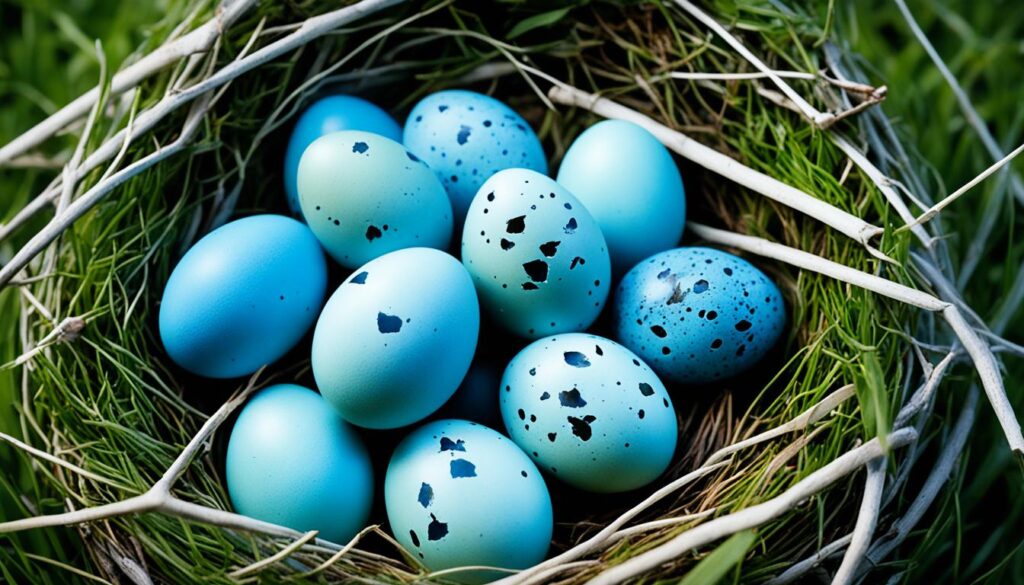Have you ever seen a nest with eggs that are a bright blue color? You might wonder, “What bird laid those?” The study of bird eggs, called avian oology, shows us many colors, including blue. Blue eggs are truly amazing.
One sunny morning, Sarah was in her garden, enjoying the birds around her. She saw a bird with bright blue feathers flying in her oak tree. Curious, she looked closer and found a nest with blue eggs inside.
This was a moment of wonder for Sarah. She had never seen eggs like these before. It made her want to learn more about the birds that lay blue eggs.
Key Takeaways
- Many birds, like European Starlings, Blue Jays, House Finches, American Robins, and Bluebirds, lay blue or blue-green eggs.
- The blue eggs get their color from a pigment called biliverdin during their formation.
- These eggs can be light to dark blue, blue-green, or even pale ice blue.
- The blue color protects the eggs from UV rays and helps them blend in or be recognized.
- These birds face dangers from losing their homes, pollution, and climate change. We need to work to protect them.
The Phenomenon of Blue Eggs
Many birds lay blue, turquoise, or pale blue eggs. This isn’t just for looks. It helps the birds and their babies in many ways. The science behind blue eggs shows how different birds have adapted over time.
Why Do Birds Lay Blue Eggs?
Birds make their eggs blue by using a pigment called biliverdin. This pigment does several things. It protects the baby bird from harmful UV rays, makes it hard for predators to see, and helps the bird know its eggs.
The color of the egg can tell us about the mother bird. Darker blue eggs mean a strong mother. Lighter blues might mean she’s new or stressed.
Possible Explanations for Blue Egg Coloration
- Camouflage: Blue eggs might seem like they wouldn’t help hide, but they actually do in some places.
- UV Protection: The biliverdin in blue eggs protects the baby from harmful UV rays.
- Species Recognition: The blue color helps birds find their eggs easily, preventing mistakes with other birds’ eggs.
- Signaling Fitness: The intensity of the blue can show how healthy the parent bird is, which can affect finding a mate and having babies.
Blue eggs are a cool example of how birds have adapted over time. They use their eggs for many important things. From hiding from predators to protecting the baby from the sun, these eggs are amazing.
“The blue eggs of birds are a true wonder of nature, a testament to the ingenuity and diversity of avian evolution.”
European Starling
The European starling is a common bird found in Europe and North America. It’s small, with shiny black feathers and can imitate other birds’ sounds. These birds are known for their adaptability.
European starlings lay 4 to 6 pale blue eggs. These eggs are about 0.8 inches wide and 1.2 inches long. They can look like a pale winter sky or be slightly greenish or darker blue.
Starlings are aggressive birds that like to nest in trees, boxes, and similar places. Both parents take turns incubating the eggs for 12 days before the chicks hatch. This shows how they work together as parents.
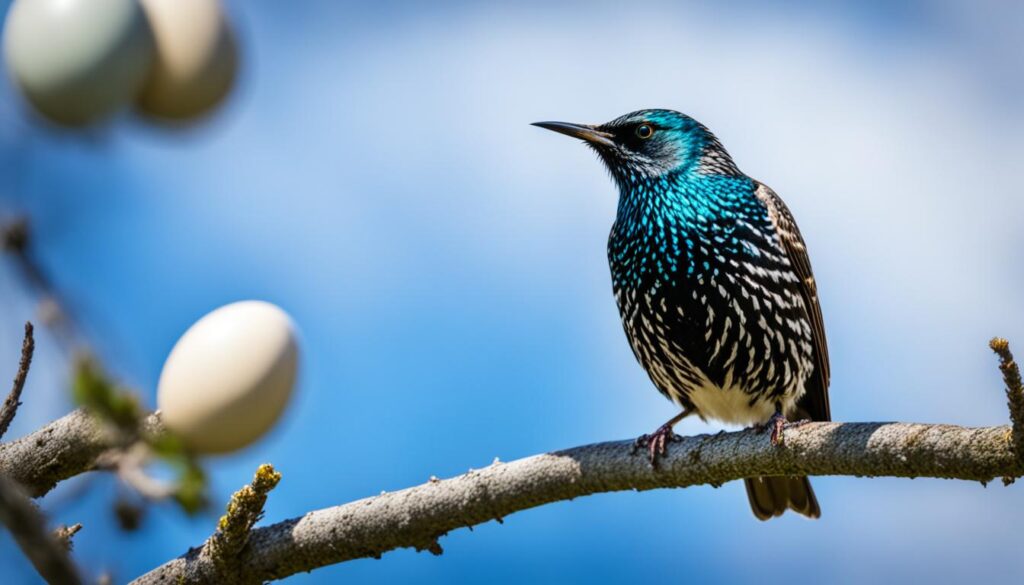
“Starlings are one of the most successful and widespread birds in the world, thanks to their adaptability and opportunistic behavior.”
Starlings are known for their looks, sounds, and ability to live in different places. They’re common in many cities and suburbs in North America. This makes them interesting for birdwatchers and nature lovers.
Blue Jay
The blue jay is a favorite among backyard birds, known for its bright colors and bold nature. These smart birds build nests high up in trees or thick shrubs. They lay their eggs in these nests, which are often messy and hard to see.
Nesting and Incubation of Blue Jay Eggs
A female blue jay lays 2 to 7 small blue eggs. These eggs are about 0.8 inches wide and 1.2 inches long. They start off pale greenish-blue but turn bright or medium blue with dark brown spots later.
The female incubates these eggs for 17 to 18 days. The male brings her food and guards the nest against predators. Blue jays can raise one or two broods each year, showing their strong family bonds.
There are about 17 million blue jays worldwide, but their numbers have dropped by 27% since 1966. They lose about 0.6% of their population each year.
“Blue Jays are rated 9 out of 20 on the Continental Concern Score, indicating a low conservation concern status.”
Blue jays often die from attacks by cats and dogs, but they still do well in many places in North America. Their blue eggs remind us of the beauty and variety in bird life.
Which birds lay blue eggs?
Many birds lay blue or blue-green eggs, not just European Starlings, Blue Jays, House Finches, and American Robins. The eggs get their blue color from biliverdin pigment. This pigment helps protect the baby bird and helps the mother recognize her eggs.
Some other birds that lay beautiful blue eggs include:
- Bluebirds
- Various Blackbird species, such as the Red-winged Blackbird
- Crows, including the American Crow
- Wood Thrush
- Grackles
- Magpies
- Gray Catbirds
The list of birds that lay blue eggs and blue egg laying birds shows how many different birds have blue eggs. Learning why they lay blue eggs helps us understand bird behavior better.
“The blue pigment on bird eggs, deposited by pigments called bilins, serves as camouflage in leafy nests, aiding in predator avoidance.”
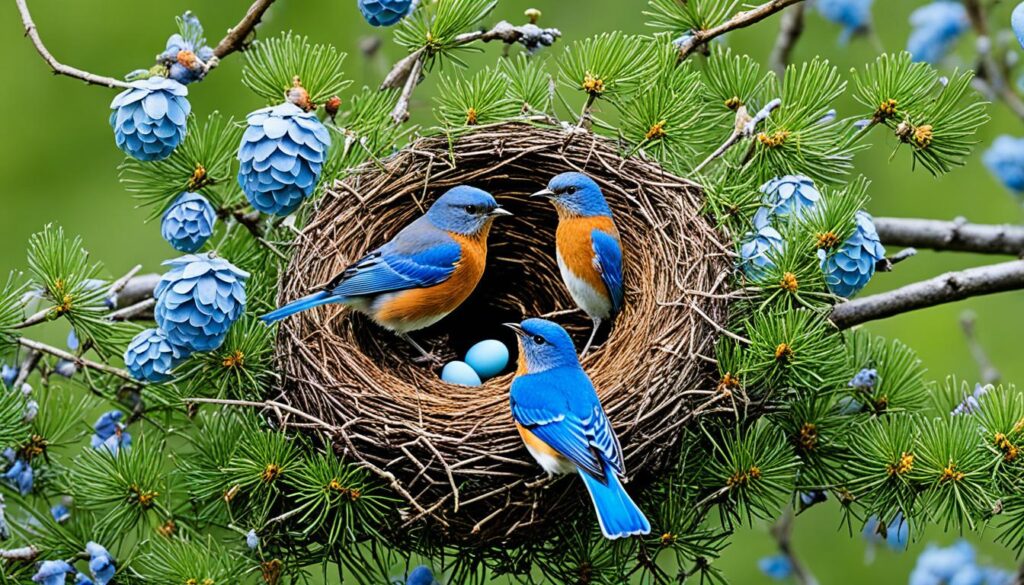
House Finch
Appearance and Incubation of House Finch Eggs
The house finch is a small, vibrant songbird found in much of North America. It’s known for its bright look. Males have a vivid red or orange head, chest, and rump. Females have brown and gray feathers.
House finches build a cup-shaped nest with small sticks and vegetation. The female lays 2 to 6 small, pale blue-green eggs. These eggs are about 0.6 inches wide and 0.8 inches long, often with purple-brown spots.
She incubates the eggs for about two weeks before they hatch. Her mate helps her during this time. House finches can have up to three broods in a season.
They are adaptable and can live in many places, from cities to countryside. Despite some declines due to disease, they are still common in the U.S.
“The house finch is a true marvel of nature, with its vibrant colors and impressive breeding prowess. These resilient birds have become a cherished part of the avian landscape across North America.”
American Robin
The American Robin is a favorite among backyard birds, known for its beautiful blue eggs. These eggs, usually 3 to 5 in a clutch, shine with a vibrant blue color. They can be a deep azure or a greenish-blue. The american robin egg is about 0.8 inches wide and 1.2 inches long. The female incubates them for 12-14 days.
Robins build their nests with a mud base and grasses, twigs, and other plants. They can nest from the ground to high in trees. In the southern US, they can raise two to three broods a year.
“Robins typically build their nests with a cup-like structure using a mud base, grasses, twigs, and other plant materials.”
The american robin egg color comes from a pigment called biliverdin. This pigment makes the eggs blue, with the shade varying. Smaller eggs and those laid first are often more vibrant.
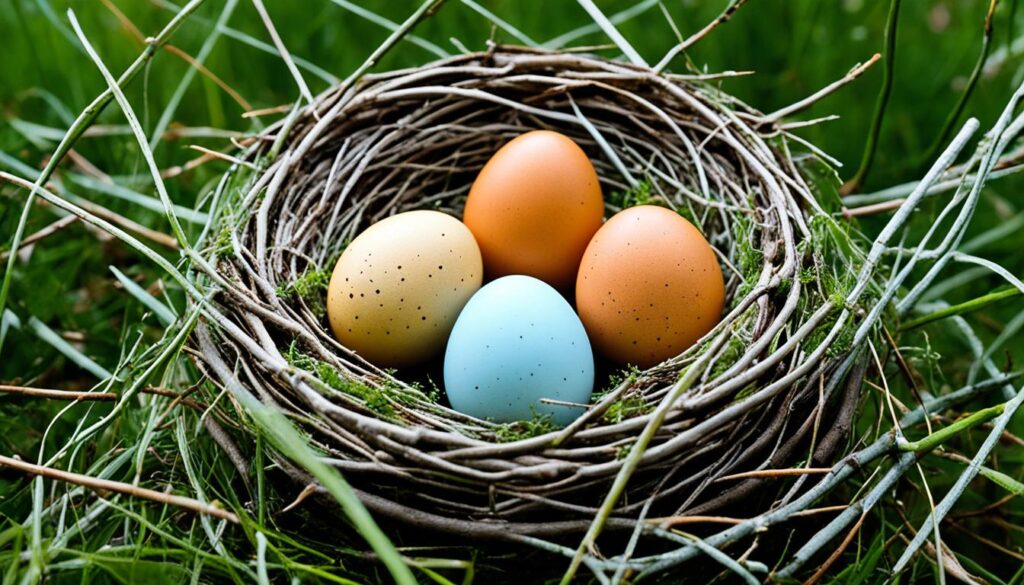
Robins are great parents, with the male feeding the chicks from the brightest eggs more. This shows a link between egg color, the mother’s health, and the chicks’ quality. But, it’s illegal in the US to raise wild baby birds, including those found abandoned.
Bluebirds
Bluebirds are a favorite in many backyards and meadows across the United States. They are known for their bright blue feathers and unique way of nesting. They lay 4 to 5 sky blue eggs in a nest in a tree or a special box. Sometimes, you might find a white or pale pink egg in some nests.
Bluebird eggs are about 0.8 inches wide and 0.9 inches long. The female bluebird incubates them for 13 to 20 days. This hard work helps bring new bluebirds into the world.
Bluebird Nesting Habits and Eggs
Thanks to nest boxes, bluebird populations have grown a lot. These boxes, without a perch and in open areas, help bluebirds raise up to three broods a year.
“Bluebirds are a beloved sight in many backyards and meadows across the United States.”
- Bluebirds usually lay 4 to 5 eggs, but sometimes up to 7.
- Their breeding season lasts about 83 days, almost three months.
- Eggs are incubated for 11 to 19 days, averaging 13.5 days.
- The female starts incubating eggs on the day she lays the last one, or a day before.
- In warmer areas, bluebirds incubate eggs for less time than in colder places.
- Only the female bluebird incubates the eggs; the male doesn’t help.
The bluebird nesting process is both fascinating and rewarding. Their blue eggs and caring nature make watching them in the wild a joy.
Blackbirds
Blackbird species, like the Red-winged Blackbird, have eggs that are blue-green with dark scribbles. These blackbird eggs are usually found in clutches of 2 to 5. They are about 0.8 inches wide and 1.1 inches long.
The blackbird nesting process is quite impressive. The female Red-winged Blackbird incubates her eggs for 11 to 13 days. Her mate stays alert, watching for predators. They live in marshes and shrubs and can have up to three broods in a season.
The blackbird egg color varies from pale blue to grayish or greenish-blue. These eggs are not just beautiful but also interesting to birdwatchers and nature lovers.
“Blackbirds are not only known for their melodic songs, but also for their striking, beautifully patterned eggs that can be found in their nests throughout the spring and summer months.”
Learning about blackbird eggs, nesting, and behavior helps us appreciate the beauty of birds in nature.
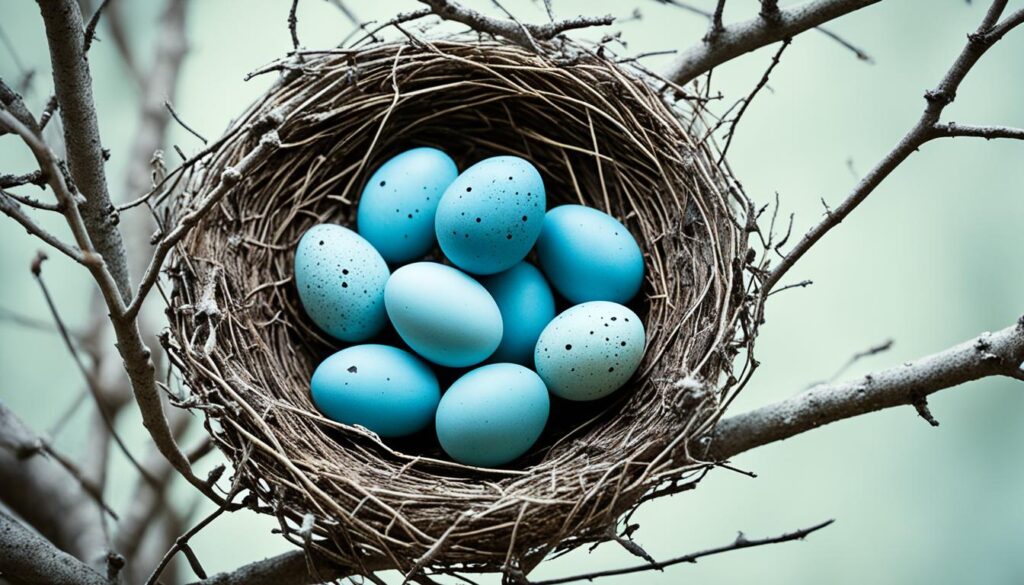
Crows
The American Crow is a bird that lays blue eggs, making it quite interesting. These smart birds are known for their unique cawing and living in many places. They can be found in cities and the countryside.
Nesting and Incubation of Crow Eggs
The American Crow belongs to the Corvidae family. They lay 3 to 9 eggs, which are about 1.2 inches wide and long. These eggs are a light blue or pale green-blue color with dark speckles.
The female crow incubates her eggs for 16 to 18 days. Her mate and other crows help by bringing her food and watching for dangers. Their nests are big and made of sticks, often high in trees.
These crows can have up to two broods a year. This shows how adaptable and dedicated they are to their young.
Wood Thrush
The wood thrush is a bird with stunning turquoise-green eggs. These eggs are about 1 inch long and 0.75 inches wide. They are very shiny. The female builds a nest using twigs, leaves, and other plants. She places it in a shrub or young tree, on a sturdy branch.
She lays 3 to 4 eggs and incubates them alone for 11 to 13 days. After the eggs hatch, the male helps feed the chicks. In fact, up to 40% of the eggs might not be the father’s.
The wood thrush is declining in numbers, partly due to cowbird nest parasitism. This is a big problem in areas where their forests are breaking up. Also, they need a lot of calcium to lay eggs, more than a similar-sized mammal.
“The oldest known wood thrush was a male at least 10 years, 2 months old.”
Not just the wood thrush, but other birds like the hermit thrush and the Eastern bluebird also lay blue eggs. These eggs get their color from biliverdin and protoporphyrin. These pigments help protect them from UV rays and keep them cool.
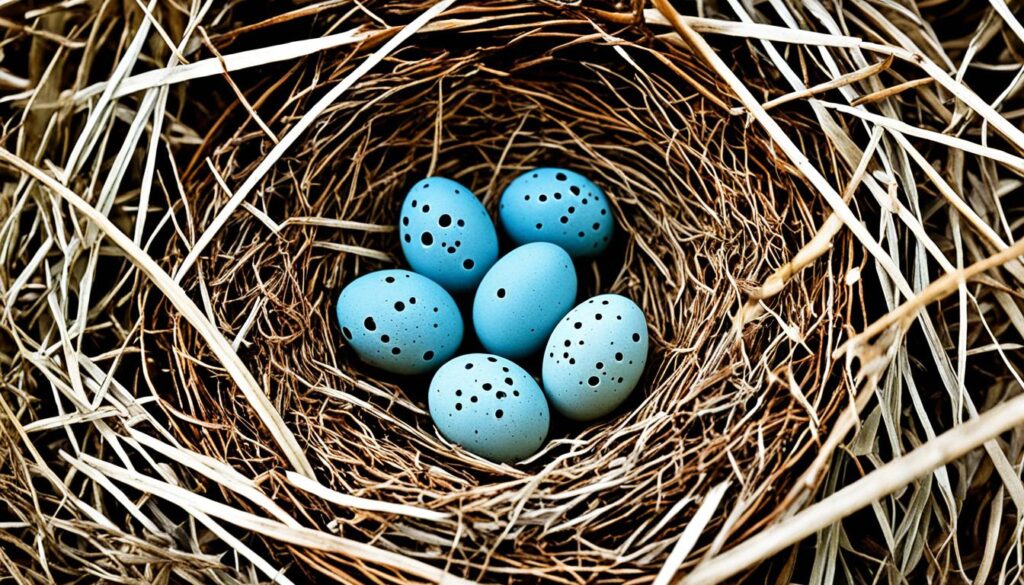
The wood thrush is a true marvel of the bird world. Its beautiful song and unique nesting habits make it special. By studying these birds, we learn more about their lives and why we must protect their homes.
Grackles
Grackles are common in backyards and parks across the United States. They are known for their grackle eggs and unique nesting habits. These blackbirds have striking iridescent feathers and can live in many different places.
The way grackles nest is quite interesting. They build big, messy nests high up in trees. They use twigs, sticks, and even paper to build them. The female grackle lays 1 to 7 grackle egg color eggs, which can be pale blue or green-gray with dark spots.
Grackle eggs are about 1.12 inches long and 0.83 inches wide. The female incubates the eggs for about 13 days. After that, the baby grackles hatch and the female takes care of them.
Grackles breed often, usually raising one brood a year. They are very adaptable and can be found in many cities and suburbs. While they may sometimes bother homeowners, grackles are an important part of our local bird life.
Magpies
The magpie is a bird that lays stunning blue eggs. The Eurasian Magpie and the North American Black-billed Magpie are famous for their blue-green eggs.
Magpie Egg Colors and Nesting
Eurasian Magpies lay 2 to 8 eggs, measuring about 1.36 inches long and 0.94 inches wide. Their eggs have a blue-green color with olive-brown speckles. In North America, the Black-billed Magpie’s eggs are more gray or tan.
Magpies build large, domed nests with twigs, grass, and mud. They often put their nests on utility poles or in tree branches. The female magpie sits on the eggs for 16 to 18 days before they hatch, showing her nesting skills.
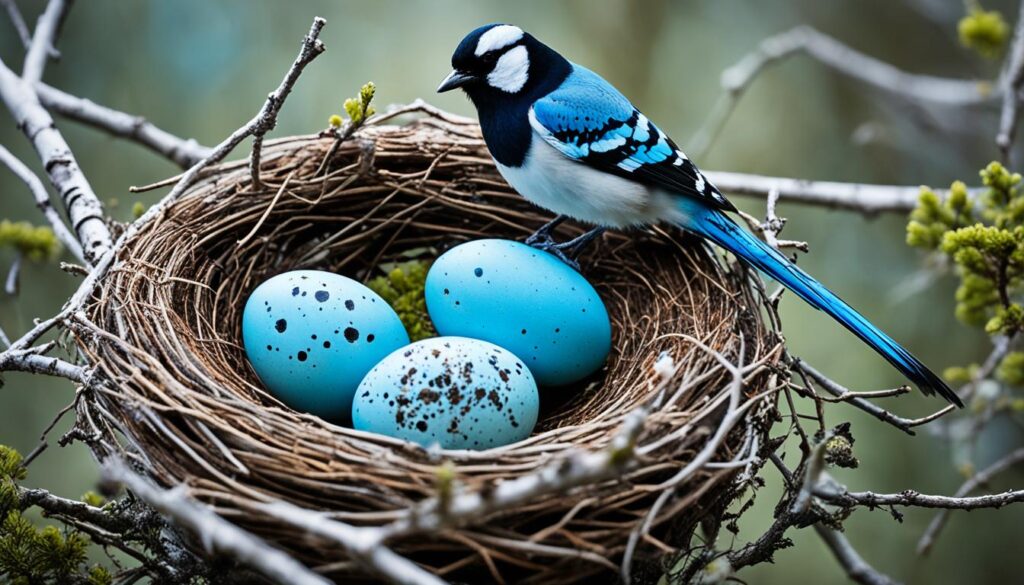
“Magpies are known for their intelligence, adaptability, and striking appearance, with their distinctive black and white plumage.”
These birds are a joy to watch. Their unique eggs show how diverse and beautiful birds can be.
Gray Catbird
The gray catbird stands out with its blue-green or sky blue eggs. These eggs are about an inch long and 0.6 inches wide. They are found in nests made of grass, twigs, and other plant material.
The female gray catbird sits on the eggs for 12 to 13 days. Her mate brings her food and guards the nest. After the eggs hatch, the chicks stay in the nest for about 10 to 11 days before they leave.
Gray catbirds often have two to three broods a season. They nest from 4 feet to 60 feet high. Their nests are in dense shrubs, small trees, or vines, usually on horizontal branches.
In the southeastern U.S., gray catbirds are fewer, but overall, they are doing well. There are about 29 million breeding birds in North America. These birds are loved by birdwatchers and nature fans for their gray catbird nesting and gray catbird eggs.
“The gray catbird is a true master of mimicry, able to impersonate the calls of numerous other bird species.”
Conclusion
The world of birds is full of amazing egg colors and patterns. Blue eggs are especially fascinating. Species like the American Robin and the Blue Jay lay these beautiful eggs.
The blue color comes from a pigment called biliverdin. This pigment helps with camouflage, protects against harm, and affects who they choose as mates.
Some birds, like Robins and Grackles, lay solid blue eggs. Others, like Magpies and Blackbirds, have eggs with speckles or patterns. This shows how different birds have unique ways to survive and thrive.
Learning about blue egg-laying birds shows us the amazing variety and importance of these eggs. As we keep exploring the bird world, blue eggs remind us of the incredible ways birds adapt and survive.
FAQ
Which birds lay blue eggs?
Many birds lay blue or blue-green eggs. This includes European Starlings, Blue Jays, House Finches, American Robins, and others.
Why do birds lay blue eggs?
The blue color comes from the bird’s bile pigment. This pigment makes the eggs light to dark blue, blue-green, or pale ice blue. It protects the eggs from UV rays and helps with camouflage and egg recognition.
What are the benefits of blue eggs?
Blue eggs protect the embryo from UV radiation. They also help the mother bird recognize her eggs. The shade of blue can show the mother’s health and the nesting cycle stage.
What species of birds are known to lay blue eggs?
Besides European Starlings and others, many birds lay blue or blue-green eggs. This includes Bluebirds, Blackbirds, Crows, Wood Thrush, Grackles, Magpies, and Gray Catbirds.
How do European Starling eggs look like?
European Starlings lay 4 to 6 pale blue eggs. They can be plain or have small dark spots. These eggs are about 0.8 inches wide and 1.2 inches long, looking like a pale winter sky.
How do Blue Jay eggs look like?
Blue Jays lay 2 to 7 small blue eggs in a messy nest. They start pale greenish blue and turn bright or medium blue with dark spots.
How do House Finch eggs look like?
House Finches lay 2 to 6 small, pale blue-green eggs. Their eggs are about 0.6 inches wide and 0.8 inches long, with purple-brown speckles.
How do American Robin eggs look like?
American Robins lay 3 to 5 shiny blue eggs in a twig nest. These eggs are bright blue, greenish-blue, or very pale blue with dark speckles.
How do Bluebird eggs look like?
Bluebirds lay 4 to 5 sky blue eggs in a tree or nest box. Their eggs are usually plain blue but can have a white or pale pink egg too.
How do Blackbird eggs look like?
Blackbirds lay 2 to 5 pale blue eggs with dark patterns. Their eggs can also be grayish or greenish-blue.
How do Crow eggs look like?
American Crows lay 3 to 9 eggs that are dull pale blue or green-blue with dark speckles. The speckling can be faint or all over the egg.
How do Wood Thrush eggs look like?
Wood Thrushes lay 3 to 4 turquoise-green eggs in a twig nest. These eggs are one inch long, 0.75 inches wide, and shiny.
How do Grackle eggs look like?
Common Grackles lay 1 to 7 eggs that are pale blue with dark spots and lines. They can also be green-blue or green-gray.
How do Magpie eggs look like?
Eurasian Magpies lay 2 to 8 eggs that are blue-green with speckling. In North America, the Black-billed Magpie’s eggs are gray or tan, not blue-green. The Yellow-billed Magpie lays pale greenish-blue eggs with speckles.
How do Gray Catbird eggs look like?
Gray Catbirds lay one to six eggs that are a beautiful blue color. They range from bright sky blue to pale blue or sea-green blue. Sometimes, they have reddish spots too.
